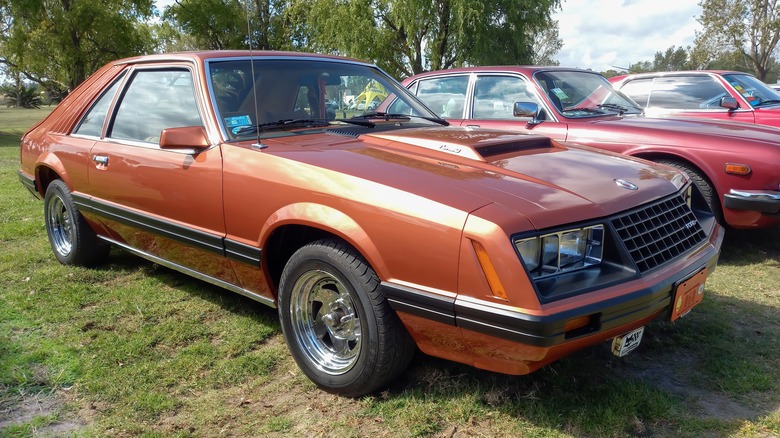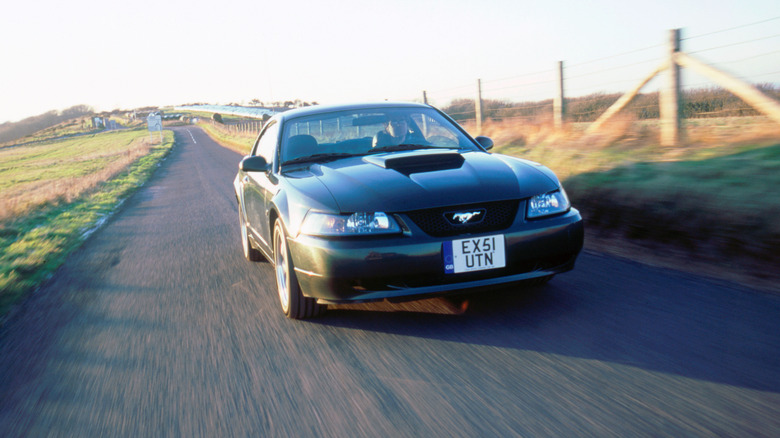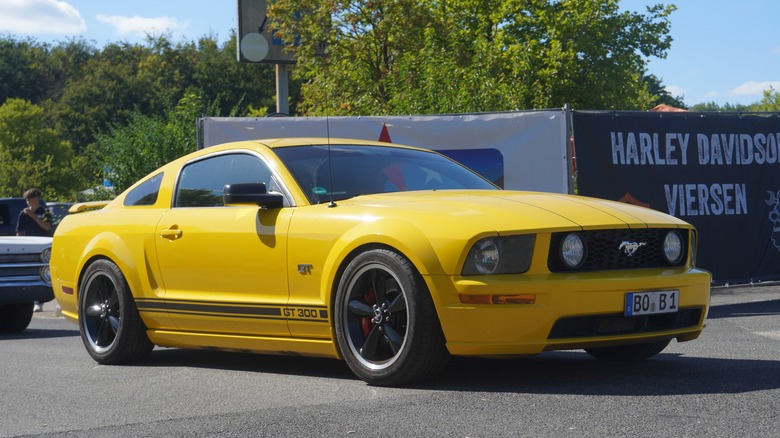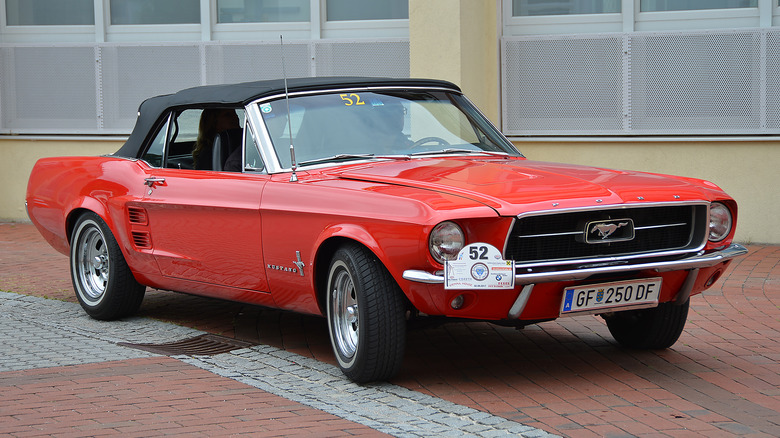4 Of The Best Mustangs To Coyote Swap
The Ford Mustang was an instant hit after its introduction at the 1964 World's Fair; Ford sold more than 400,000 in the following year. The base engine in the first Mustang was an underperforming I6 that produced less than 100 horsepower, but by 1966, Mustang engine options expanded to include a bigger straight six and three versions of Ford's 289 cubic-inch V8. Engine technology has grown leaps and bounds since then, and Mustang GT models since 2011 have been powered by Ford's Coyote V8. That motor is now in its fourth generation and has been produced in displacements ranging from 4.95 to 5.2 liters. The most powerful version is the supercharged 5.2 liter in the Mustang GTD, a GT3-based beast that makes upwards of 800 horsepower.
The 10 or so variants of Coyote V8s make great swap candidates for many older Mustangs, not just the anemic I6-powered first-year models. The Coyote's large size and modern electronics mean not every older Mustang is a willing recipient, however. We've compiled a list of four vintage Mustangs that will accept a Coyote V8 upgrade with a fair amount of planning, some fabrication or adaptation, and likely a whacked knuckle or seven. None of these swaps are as simple or cheap as yanking the old engine and dropping in the Coyote, so read on carefully and open up your checkbook.
Fox Body Mustang (1979-1993)
The third-generation Mustang produced between 1979 and 1993 is generally known as the 'Fox Body' Mustang since it was built on the Fox platform. By the time the Fox Body's run ended, Ford had made more than 2.6 million, which makes them easy to come by and relatively cheap on the secondhand market. That's a good thing, because even though many '80s Mustangs had a 5.0 liter V8, a Coyote of the same displacement is much larger and requires substantial modifications to the car for a proper fit. The major effort required for this swap is worth the trouble, as you'll end up with a 400-500 horsepower engine in a 3,000-pound car. Late Model Restoration and TD Motion sell pre-fabricated Fox body Coyote swap kits that will shave many hours off of this project, but they will also take a bite out of your budget.
To complete this swap, you'll need to replace the motor mounts and brake booster, modify the K-member and sway bar, install new exhaust, and replace the oil pan and filter. You'll also need a new engine computer and electronic throttle. The Fox body transmissions aren't built to handle the power of a Coyote engine, so you'll also need to drop in a newer Tremec T56 six-speed manual or 4R70W four-speed automatic. As previously said, this is a great swap once finished, but it's neither easy nor inexpensive to complete.
New Edge Mustang (1999-2004)
The New Edge Mustang, which debuted in 1999 as a mid-fourth-generation refresh, presents an easier project but just as satisfying of a result as a Fox Body Coyote swap. New Edge Mustangs weigh a few hundred pounds more than their Fox body brethren, and the swap is similar but quite a bit simpler. New Edge Mustangs have modular engines akin to the Coyote, but you'll still need to worry about configuring a new oil pan, K-member. and exhaust headers.
Picking up a Coyote control pack from American Muscle or CJ Pony Parts will speed up your installation by providing you with the correct power control and distribution modules, harnesses, and sensors, along with the required computer-controlled throttle. You'll also need to install a fuel return line to the tank. Like with a Fox body upgrade, you'll probably want to upgrade your transmission as well, along with the clutch and flywheel or flexplate.
S197 Mustang (2005-2009)
The fifth-generation Mustang S197 debuted in 2005 with a body reminiscent of the '60s classics. It lasted through 2014, and the Coyote became the GT version's powerplant three years prior to that. 2005-09 S197s had a 4.0 liter V6 as the base engine, with 4.6 and 5.4 liter V8s on the option sheet. These models benefit greatly from the power upgrade a Coyote swap offers, and this is a job that's far less painstaking than a New Edge or Fox Body swap.
Make it Modular sells a plug-and-play wiring harness for $1,000 that integrates 2011-2014 Coyote engines into 2005-2009 Mustangs with minimal splicing. This swap can be done in a couple full days of work and is far simpler than any of the others on this list, although a transmission upgrade is still recommended like with other Coyote swaps. If you're pulling a V6 from your Mustang to replace with a Coyote V8, you should also upgrade the stock 7.5-inch rear end with a stronger 8.8-inch axle that can handle the additional horsepower.
First Generation Mustang (1965-1973)
Swapping a Coyote V8 into a first-generation Mustang won't be easy by any means, but when (if) you finish, you'll have a timeless classic updated with a thoroughly modern powertrain. This is a daunting but doable task that requires a little fabrication, a lot of forethought, and a lack of concern for the ultimate cost. A Coyote engine won't fit in a first-gen Mustang without cutting out the shock towers and installing an alternate suspension system. Detroit Speed's Aluma-Frame complete front suspension can be welded to the frame of your Mustang and features easily adjustable camber and caster, but it will set you back a minimum of $7,200.
You'll also have to weld in a new transmission tunnel to make room for a T56 or other modern gearbox, and some Detroit Speed mini-tub wheel wells to make room for an upgraded rear axle and wider tires. This is a more complex job than other Mustang Coyote or Chevy LS swaps, but the final result is spectacular if done carefully. Owner Byron Tudor had a 435-horsepower Coyote 5.0 put in his 1967 Mustang by Auburn, Washington fabrication expert Craig Wick and told Motor Trend, "The Coyote is so powerful and yet so smooth and comfortable to drive, I think it's the perfect blend of vintage and modern."




